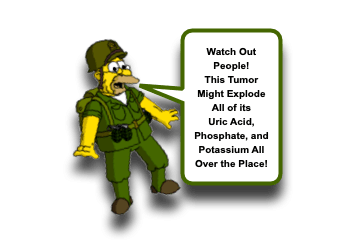Tumor Lysis Syndrome

The lysis of tumor cells is one of the goals of successful treatment of cancer. Unfortunately, “Cancer SUCKS!” and even when the tumor is being positively affected, it can still unleash havoc. Oncologic processes are associated with a variety of emergencies (ex, Neutropenic Fever, Typhlitis, Central Lines, and Pulmonary Embolism), but one that deserves special attention may lead to very dramatic presentations! Let’s take a minute to review Tumor Lysis Syndrome:
Tumor Lysis Syndrome: Basics
- Tumor Lysis Syndrome (TLS) is an oncologic emergency!
- Despite best efforts, TLS can occur even when preventative measures are taken. [Naeem, 2019]
- TLS can occur spontaneously in highly aggressive tumors. [Naeem, 2019]
- Children tend to be at greater risk for TLS: [Tazi, 2011]
- More likely to suffer from higher-risk malignancies.
- Lymphomas and leukemias have high tumor burdens and are highly proliferative.
- Due to the Spontaneous or Treatment-Associated destruction of tumor cells. [Naeem, 2019; Tazi, 2011; Zonfrillo, 2009]
- Tumor lysis leads to:
- HYPERkalemia
- Most life-threatening consequence
- May result in mild symptoms (ex, cramps, weakness, fatigue, nausea, vomiting, irritability) or overt dysrhythmias or death.
- HYPERphosphatemia
- Worsened by renal insufficiency.
- Leads to lethargy, nausea, vomiting, diarrhea, and seizures!
- Phosphate + Calcium precipitation leads to renal failure.
- HYPERuricemia
- High cellular turnover produce lots of purine nucleic acids (DNA is being broken down).
- Nucleic acid metabolism leads to excess uric acid accumulation.
- Results in nephropathy, which is worsened by concomitant dehydration and nephrotoxic medications.
- HYPOcalcemia
- Due to calcium combining with excess phosphate.
- Leads to cramps, tetany, prolonged QT interval, seizures, or dysrhythmias.
- HYPERkalemia
- Lymphoblasts actually contain 4 times the amount of phosphate compared to normal lymphocytes! [Zonfrillo, 2009]
- Tumor lysis leads to:
- Laboratory vs Clinical Tumor Lysis Syndrome [Rajendran, 2013; Tazi, 2011; Zonfrillo, 2009]
- Laboratory TLS is more commonly encountered than Clinical TLS. [Naeem, 2019]
- Laboratory TLS = 2 or more of the following
- K+: >/= 6.0 mEq/L or 25% INcrease from baseline
- Phos: >/= 6.5 mg/dL or 25% INcrease from baseline
- Uric Acid: >/= 8.0 mg/dL or 25% INcrease from baseline
- Ca+: </= 7.0 mg/dL or 25% DEcrease from baseline
- ionized Ca+: <1.12
- Clinical TLS = presence of Laboratory TLS and on of the following:
- Acute Renal Insufficiency/Failure – Creatinine 1.5 times or more upper limit for age, oliguria
- Seizure
- Cardiac Dysrhythmia
- Cardiac Arrest
- Sudden Death
Tumor Lysis Syndrome: Risk Factors
- Tumor Characteristics [Rajendran, 2013]
- Malignancies prone to have rapid lysis
- Acute Leukemia, especially with high total lymphocyte counts (>1,000,000/microL)
- Non-Hodgkin’s Lymphomas (ex. Burkitt’s)
- Large tumor burden
- Bone marrow involvement
- Hyperleucocytosis
- Extramedullary disease (ex, massive splenomegaly)
- Malignancies prone to have rapid lysis
- Host Characteristics [Rajendran, 2013]
- Small children with large tumors
- Clinical dehydration (accentuates renal impairment)
- Associated Risk Factors [Rajendran, 2013]
- Nephrotoxic medications (ex, vancomycin)
- Tumor infiltration of the kidney or obstructing the ureters
- Highly effective therapies (ex, Rituximab destroys non-Hodgkin cells avidly)
Tumor Lysis Syndrome: Management
- High Index of Suspicion is required!
- Can occur SPONTANEOUSLY (prior to chemotherapy)! [Tazi, 2011]
- Have a low threshold for considering and testing!
- EARLY IDENTIFICATION IS IMPERATIVE [Rajendran, 2013; Tazi, 2011]
- Check:
- Chemistry Panel
- Uric Acid
- Lactate Dehydrogenase (LDH) Level
- Urinalysis
- CBC w/ Diff
- ECG
- Treatment considerations: [Rajendran, 2013]
- Hyper-hydration
- This is imperative to both help prevent TLS and treat it!
- Fluids often titrated to keep urine output >2 mL/kg/hr.
- Obvious care to prevent volume overload must be taken.
- Electrolyte Derangement Management
- Calcium gluconate (2 mL/kg of 10%) to stabilize cardiac membranes.
- Insulin and Glucose to help shift K+ intracellular.
- If producing urine, Furosemide can help augment K+ excretion once urine output is adequate.
- Oral phosphate binders – aluminum hydroxide or calcium carbonate.
- Allopurinol or Rasburicase for hyperuricemia.
- Allopurinol (10 mg/kg/Day divided q8 hrs) often used as a preventative measure.
- Rasburicase (recombinant urate oxidase) can reduce need for hemodialysis.
- Often a single dose of Rasburicase (0.20 mg/kg IV) is sufficient (which is good, because it is expensive). [Rajendran, 2013]
- Urine Alkalinization is controversial!
- Hemodialysis
- May be required for Clinical TLS
- Hyper-hydration
Moral of the Morsel
- Cancer Sucks! For many reasons.
- Tumor Lysis Syndrome can be subtle at first. May have symptoms similar to those caused by cancer therapies (ex, nausea, vomiting).
- Don’t overlook the potential for Tumor Lysis Syndrome! Have a low index of suspicion as early detection and therapy can avoid disaster… even in children just diagnosed!
- Treat aggressively! Give fluids, calcium, phosphate binders, and Rasburicase.
References
Naeem B1, Moorani KN2, Anjum M3, Imam U4. Tumor lysis syndrome in pediatric acute lymphoblastic leukemia at tertiary care center. Pak J Med Sci. 2019 Jul-Aug;35(4):899-904. PMID: 31372114. [PubMed] [Read by QxMD]
Rajendran A1, Bansal D, Marwaha RK, Singhi SC. Tumor lysis syndrome. Indian J Pediatr. 2013 Jan;80(1):50-4. PMID: 22752730. [PubMed] [Read by QxMD]
Tazi I1, Nafl H, Elhoudzi J, Mahmal L, Harif M. Management of pediatric tumor lysis syndrome. Arab J Nephrol Transplant. 2011 Sep;4(3):147-54. PMID: 22026339. [PubMed] [Read by QxMD]
Zonfrillo MR1. Management of pediatric tumor lysis syndrome in the emergency department. Emerg Med Clin North Am. 2009 Aug;27(3):497-504. PMID: 19646650. [PubMed] [Read by QxMD]

